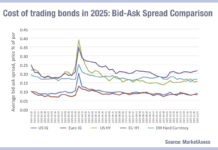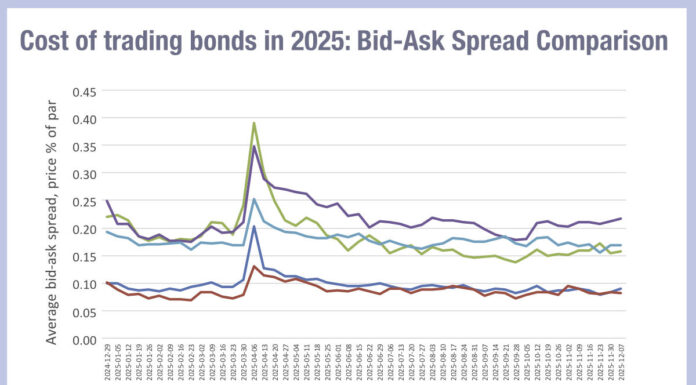 How do you avoid information leakage? Does this change if half the market is trading with a single counterparty? Knowing that electronic market maker, Jane Street, reports a monthly bond trading volume of US$230 billion globally, with a 48% market share of US investment grade and 33% of US high yield, buy-side trading desks need to think in new ways about filling orders.
How do you avoid information leakage? Does this change if half the market is trading with a single counterparty? Knowing that electronic market maker, Jane Street, reports a monthly bond trading volume of US$230 billion globally, with a 48% market share of US investment grade and 33% of US high yield, buy-side trading desks need to think in new ways about filling orders.
As electronic liquidity providers move further into the credit space, buy-side traders report they are delivering consistent and tight pricing. A big part of their capacity is managed via their central risk books, which allow them to trade in and out of positions around the clock and across markets in order to maximise opportunities and minimise risks. Clearly, if they are able to deliver optimal pricing as a result of their model, there is a payoff for investors.
The dynamic that needs exploring is whether this payoff is better than could be achieved by masking trading activity from an electronic liquidity provider.
A similar argument exists in the retail market, where payment for order flow (PFOF) allow market makers to offer fee-free trading to retail brokers’ users because paying for the order flow allows them a more profitable business through the gained insights into trading activity than could otherwise be achieved.
For retail traders, removing fixed-fee trading costs allows smaller amounts of money to be invested and offers access to poorer members of society. If the price they pay pre security is not materially worse than paying the price plus a trading fee, the value of the system is greater.
Traders are risk managers and the outcome they need to achieve depends upon their investment goals. If they can achieve these goals more effectively through using trading protocols on platforms that allow them to interact with electronic market makers, they can manage risk more effectively. These include the use of anonymous trading protocols, as well as direct streaming with major counterparties.
Some of these protocols – such as portfolio trading – have rocketed in use, as the value of trading both liquid and illiquid bonds simultaneously reduces the risk of a portfolio left holding an overweight level of illiquid bonds.
It may well be that outsized market shares are here to stay for big quantitative market makers, in competition with major banks, at least while their models deliver the best execution for buy-side desks. Yet, buy-side traders need to be cognisant of the awareness that these counterparties may have of their activity, and the implications.
©Markets Media Europe 2025















